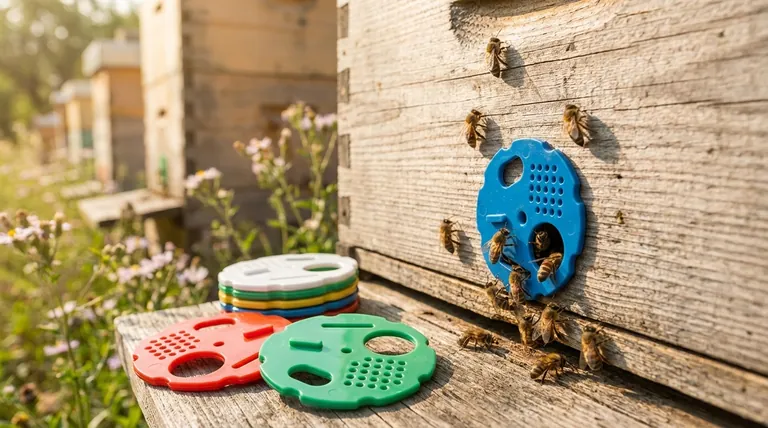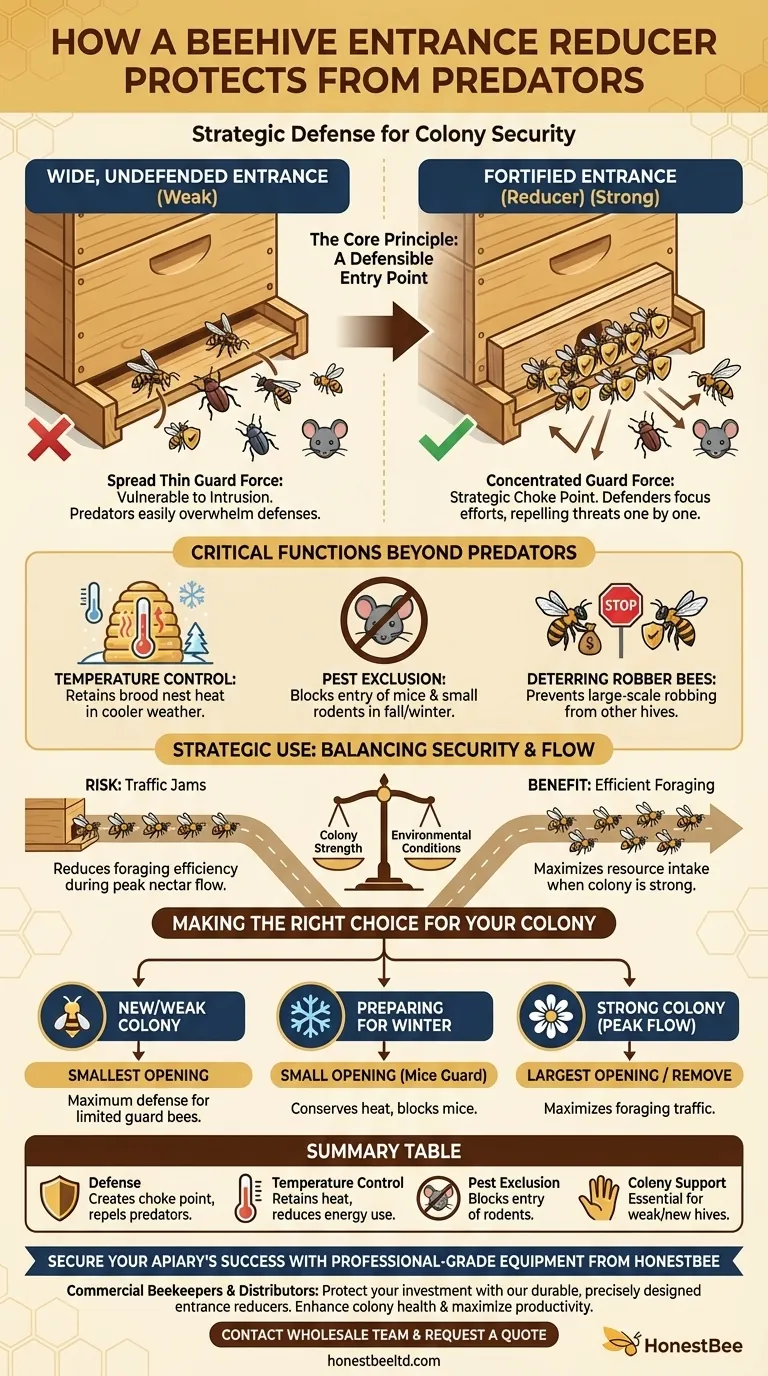The primary function of a beehive entrance reducer is to shrink the hive's main opening, making it a smaller, more manageable space for the colony's guard bees to defend. This simple act creates a strategic choke point, allowing a small number of guards to effectively repel predators, robber bees, and other pests that would easily overwhelm a wide, undefended entrance.
While often seen as a simple block of wood, the entrance reducer is a critical management tool that empowers a honeybee colony by concentrating its defensive resources, especially during periods of vulnerability.

The Core Principle: A Defensible Entry Point
An entrance reducer fundamentally changes the tactical situation at the hive's front door. It transforms a wide, vulnerable opening into a fortified gate.
Reducing the "Front Line"
A large entrance requires many guard bees to patrol its entire length. This spreads the colony's defensive force thin, creating weak spots for intruders to exploit.
By physically shrinking the entrance, the reducer minimizes the area that needs to be defended at any given moment.
Concentrating Guard Bee Efforts
With a smaller opening, the existing guard bees can focus their attention on a single point. This concentration of force makes their defensive efforts far more effective against individual threats like wasps or robber bees from other hives.
It creates a bottleneck where invaders can be inspected and repelled one by one, rather than swarming in through a wide gap.
Aiding Weaker or Newer Colonies
The size of a colony's "army" is directly proportional to its population. A new, small, or weakened hive has far fewer bees available for guard duty.
For these vulnerable colonies, an entrance reducer is not just helpful—it is essential for survival. It allows their limited defensive force to successfully protect the hive's precious resources and developing brood.
Beyond Predators: Other Critical Functions
The benefits of an entrance reducer extend beyond just defense. It is a multi-purpose tool that helps regulate the hive's internal environment.
Regulating Hive Temperature
In cooler weather, a large opening allows heat to escape rapidly. An entrance reducer helps trap warm air inside, reducing the energy the bees must expend to maintain the critical temperature of the brood nest.
Preventing Entry by Larger Pests
During the fall and winter, mice and other small rodents often seek shelter in the warmth of a beehive. A standard entrance reducer is specifically sized to block the entry of mice while still allowing bees to pass.
Deterring Robber Bees
Robber bees from stronger, nearby hives will attempt to steal honey, especially during a nectar dearth. A reduced entrance makes it much harder for these robbers to slip past the guards and initiate a full-scale robbing event, which can decimate a weaker colony.
Understanding the Trade-offs
Using an entrance reducer is a strategic decision, and its application must adapt to the colony's condition and the time of year.
The Risk of "Traffic Jams"
The primary drawback of a reducer is that it can limit the flow of traffic. During a strong nectar flow, a small entrance can become a bottleneck for foraging bees trying to enter and exit.
This "traffic jam" can reduce the colony's foraging efficiency and slow the rate at which they bring in resources.
Knowing When to Adjust
Strong, populous hives during the peak of summer often do not need a reducer. Their massive population provides more than enough guard bees to defend a full-size entrance.
Beekeepers must monitor their hives and be prepared to adjust the entrance size—or remove the reducer entirely—to match the colony's strength and the environmental conditions.
Making the Right Choice for Your Colony
The decision to use an entrance reducer and which opening to select depends entirely on your colony's specific situation.
- If your colony is new or weak: Use the smallest opening to give your limited number of guard bees the best possible defensive advantage.
- If you are preparing for winter: Use the reducer's smaller opening to conserve heat and, most importantly, to prevent mice from entering the hive.
- If your colony is strong and in a peak nectar flow: Consider using the largest opening or removing the reducer completely to maximize foraging efficiency.
Ultimately, viewing the entrance reducer as an adaptable tool is the key to promoting a secure, healthy, and productive hive.
Summary Table:
| Function | Key Benefit |
|---|---|
| Defense | Creates a choke point for guard bees to repel predators and robbers. |
| Temperature Control | Helps retain heat in the brood nest during cooler weather. |
| Pest Exclusion | Blocks entry from mice and other small rodents. |
| Colony Support | Essential for the survival of new, small, or weakened hives. |
Secure your apiary's success with professional-grade equipment from HONESTBEE.
As a commercial beekeeper or distributor, protecting your investment is paramount. Our durable, precisely designed entrance reducers are part of a full suite of wholesale beekeeping supplies built to enhance colony health and maximize productivity.
Let us help you fortify your hives. Contact our wholesale team today to discuss your equipment needs and request a quote.
Visual Guide

Related Products
- Multi-Functional Rotary Hive Entrance Disc for Beekeeping
- HONESTBEE Advanced Ergonomic Stainless Steel Hive Tool for Beekeeping
- Multi-Functional Sliding Hive Entrance for Beekeeping
- Professional Insulated Winter Hive Wrap for Beekeeping
- Professional Multi-Component Bucket Wasp Trap
People Also Ask
- What are the four entrance options provided by the steel entrance disc? Master Hive Traffic & Protection
- What are some alternative strategies to using entrance reducers? Empower Your Bees for Natural Hive Defense
- What are the adjustable functions of the circular metal beehive entrance disc? Master Hive Access Control
- What is the purpose of the steel entrance disc? Master Hive Traffic Control & Security
- What does a fully closed setting on a round beehive entrance disc indicate? A Guide to Hive Security



















